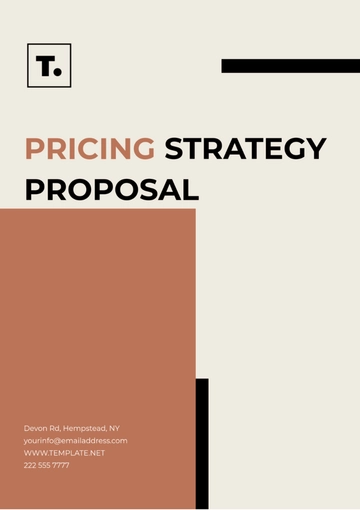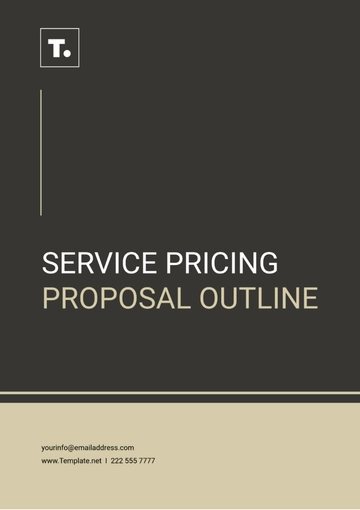BUSINESS PRICING PROPOSAL
Prepared by: [Your Name]
I. Introduction
In today's competitive business environment, establishing a well-informed and strategic pricing model is crucial for organizational success and sustainability. This proposal provides a comprehensive overview of a structured pricing strategy aimed at enhancing profitability, competitive advantage, and customer engagement. Our approach is rooted in market analysis, cost assessment, and value proposition alignment.
II. Market Analysis
A. Industry Overview
The current market landscape is characterized by rapid technological advancements, shifting consumer preferences, and heightened competition. This necessitates the adoption of a flexible pricing model that can adapt to market dynamics and offer optimal value to both the company and its customers.
B. Competitor Pricing
Understanding the pricing strategies of competitors is pivotal in positioning our offerings competitively. An analysis of competitor pricing reveals the industry standards and price elasticity of demand within the sector. By benchmarking against key competitors, our pricing strategy seeks to deliver superior value through differentiated offerings.
III. Cost Assessment
A. Fixed and Variable Costs
A thorough evaluation of both fixed and variable costs is essential for setting prices that not only cover expenses but also deliver a favorable margin. Fixed costs include elements such as infrastructure and management salaries, while variable costs encompass materials, production, and distribution expenses.
Cost Type | Amount (USD) |
|---|
Fixed Costs | $500,000 |
Variable Costs | $300,000 |
B. Break-even Analysis
The break-even analysis provides insights into the minimum sales volume required to cover total costs. It is a vital tool in determining the viability of proposed pricing strategies, ensuring financial sustainability and risk mitigation.
IV. Proposed Pricing Strategy
A. Value-based Pricing
Value-based pricing focuses on setting prices primarily based on the perceived value to customers rather than on the cost of the product or historical prices. This approach not only enhances customer satisfaction but also maximizes the revenue potential for high-value products and services.
B. Tiered Pricing Model
Implementing a tiered pricing model allows for targeted market segmentation, catering to various customer segments with differentiated needs and price sensitivity. The tiers can be structured to include basic, standard, and premium offerings, each with distinct features and pricing.
V. Implementation Plan
A. Timeline
The implementation of the pricing strategy will span over a six-month period. The timeline includes key milestones such as stakeholder consultations, pilot testing, market launch, and performance review.
Stage | Timeline |
|---|
Stakeholder Consultations | Month 1 |
Pilot Testing | Month 2-3 |
Market Launch | Month 4 |
Performance Review | Month 5-6 |
B. Evaluation and Adjustment
Continuous evaluation of the pricing strategy's effectiveness will be conducted. Metrics such as sales growth, customer feedback, and market share will guide necessary adjustments to ensure the pricing strategy remains aligned with business objectives.
VI. Conclusion
In conclusion, this comprehensive pricing strategy proposal integrates industry insights, cost analysis, and innovative pricing models to position the company for sustainable growth and competitive advantage. By adopting this strategic approach, we anticipate improved profitability and enhanced customer satisfaction.
VII. Authorization
This proposal requires approval from the following stakeholders to proceed with the implementation phase:
 [YOUR NAME]
[YOUR NAME]
Chief Executive Officer
 Lyda Fadel
Lyda Fadel
Chief Financial Officer
Proposal Templates @ Template.net

 [YOUR NAME]
[YOUR NAME]




























